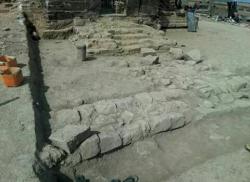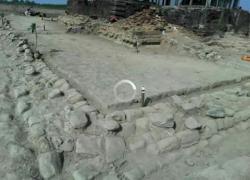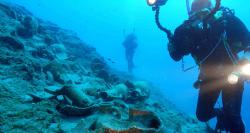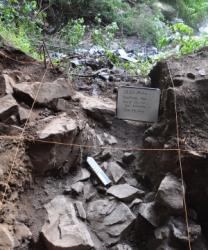INSTITUT SUPERIEUR D'ANTHROPOLOGIE
INSTITUTE OF ANTHROPOLOGY
ONLINE COURSES / COURS A DISTANCE
SPRING TERM : APRIL 2016
REGISTER NOW
MYANMAR – 
 Mrauk U - A huge ancient building was recently found in Mrauk U, an archaeological site of western Burma (Myanmar), said an officer from the local archaeology department. The building is identified as a shrine (Buddhist ordination hall) and it was found near Rampray pagoda of Kyay Pinlay village, which is six miles away from Mrauk U, informed the archaeology department of Mrauk U. U Than Myint, a local history researcher revealed that the building is around 70 feet long which was found 10 feet beneath the ground. Many unique architectural elements including a stone well were also found in the site. The Mrauk U archaeology department with the help of local villagers has initiated the excavation exercise for a week, but the process is expected to continue for nearly a month. Meanwhile, local villagers in large number have visited the site as a rumour was spread that one of the biggest ancient city well was discovered in Rampray pagoda.
Mrauk U - A huge ancient building was recently found in Mrauk U, an archaeological site of western Burma (Myanmar), said an officer from the local archaeology department. The building is identified as a shrine (Buddhist ordination hall) and it was found near Rampray pagoda of Kyay Pinlay village, which is six miles away from Mrauk U, informed the archaeology department of Mrauk U. U Than Myint, a local history researcher revealed that the building is around 70 feet long which was found 10 feet beneath the ground. Many unique architectural elements including a stone well were also found in the site. The Mrauk U archaeology department with the help of local villagers has initiated the excavation exercise for a week, but the process is expected to continue for nearly a month. Meanwhile, local villagers in large number have visited the site as a rumour was spread that one of the biggest ancient city well was discovered in Rampray pagoda.
http://narinjara.com/index.php/ancient-shrine-found-in-mrauk-u/
FRANCE - Saint-Caradec - Dans quelques jours va débuter une campagne de fouilles archéologiques préventives sur la zone industrielle de Saint-Caradec. Les sondages ont montré qu’il y a, à Bel-Air, un enclos de l’époque gallo-romaine. Ce ne sont que des fondations ceinturées par un fossé avec probablement les restes d’un talus. Il faut savoir que l’ensemble du site a été bouleversé par des centaines d’années d’exploitations agricoles. En ce type de lieu, les archéologues s’attendent à trouver des traces d’habitat, probablement sur pilotis dont les parois étaient faites en terre. Et des traces de l’existence d’une « entreprise » travaillant le métal. Vestiges qui pourraient remonter de l’âge de bronze (de 5000 à 3000 av. J.-C) jusqu’à l’époque gallo-romaine.
http://www.lecourrierindependant.fr/zi-de-bel-air-que-vont-reveler-les-fouilles-archeologiques_2744/
TURQUIE –  Marmaris - Researchers have discovered a 4,000 year-old shipwreck in Marmaris Hisarönü Gulf in the Mediterranean, as part of an ongoing project carried out by Dokuz Eylül University's Marine Sciences Institute since 2007. Professor Abdurrahman Harun Özdaş, from Dokuz Eylül University said that the 4,000 year-old shipwreck is the oldest of its kind to be found in Turkey. The shipwreck is thought to be used for trading purposes and is from the Minoan Civilization, which existed around 3650 to 1400 BCE. It is reported that the ship is thought to have capsized during a trip to Hisarönü Gulf from Cyrete through the Rhodes Island and Bozburun. It was also reported that the project found over 20 submerged harbors and architectural remains, 25 berthages and over 400 anchors dating from the Bronze Age to the Ottoman period.
Marmaris - Researchers have discovered a 4,000 year-old shipwreck in Marmaris Hisarönü Gulf in the Mediterranean, as part of an ongoing project carried out by Dokuz Eylül University's Marine Sciences Institute since 2007. Professor Abdurrahman Harun Özdaş, from Dokuz Eylül University said that the 4,000 year-old shipwreck is the oldest of its kind to be found in Turkey. The shipwreck is thought to be used for trading purposes and is from the Minoan Civilization, which existed around 3650 to 1400 BCE. It is reported that the ship is thought to have capsized during a trip to Hisarönü Gulf from Cyrete through the Rhodes Island and Bozburun. It was also reported that the project found over 20 submerged harbors and architectural remains, 25 berthages and over 400 anchors dating from the Bronze Age to the Ottoman period.
http://www.dailysabah.com/nation/2016/01/30/4000-year-old-shipwreck-belonging-to-minoans-found-in-turkey?
ETHIOPIE –  An error has forced researchers to go back on their claim that humans across the whole of Africa carry DNA inherited from Eurasian immigrants. This week the authors issued a note explaining the mistake in their October 2015 Science paper on the genome of a 4,500-year-old man from Ethiopia — the first complete ancient human genome from Africa. The man was named after Mota Cave, where his remains were found. Although the first humans left Africa some 100,000 years ago, a study published in 2013 found that some came back again around 3,000 years ago; this reverse migration has left its trace in African genomes. In the Science paper, researchers confirmed this finding. The paper also suggested that populations across the continent still harbour significant ancestry from the Middle Eastern farmers who were behind the back-migration
An error has forced researchers to go back on their claim that humans across the whole of Africa carry DNA inherited from Eurasian immigrants. This week the authors issued a note explaining the mistake in their October 2015 Science paper on the genome of a 4,500-year-old man from Ethiopia — the first complete ancient human genome from Africa. The man was named after Mota Cave, where his remains were found. Although the first humans left Africa some 100,000 years ago, a study published in 2013 found that some came back again around 3,000 years ago; this reverse migration has left its trace in African genomes. In the Science paper, researchers confirmed this finding. The paper also suggested that populations across the continent still harbour significant ancestry from the Middle Eastern farmers who were behind the back-migration
http://www.nature.com/news/error-found-in-study-of-first-ancient-african-genome-1.19258